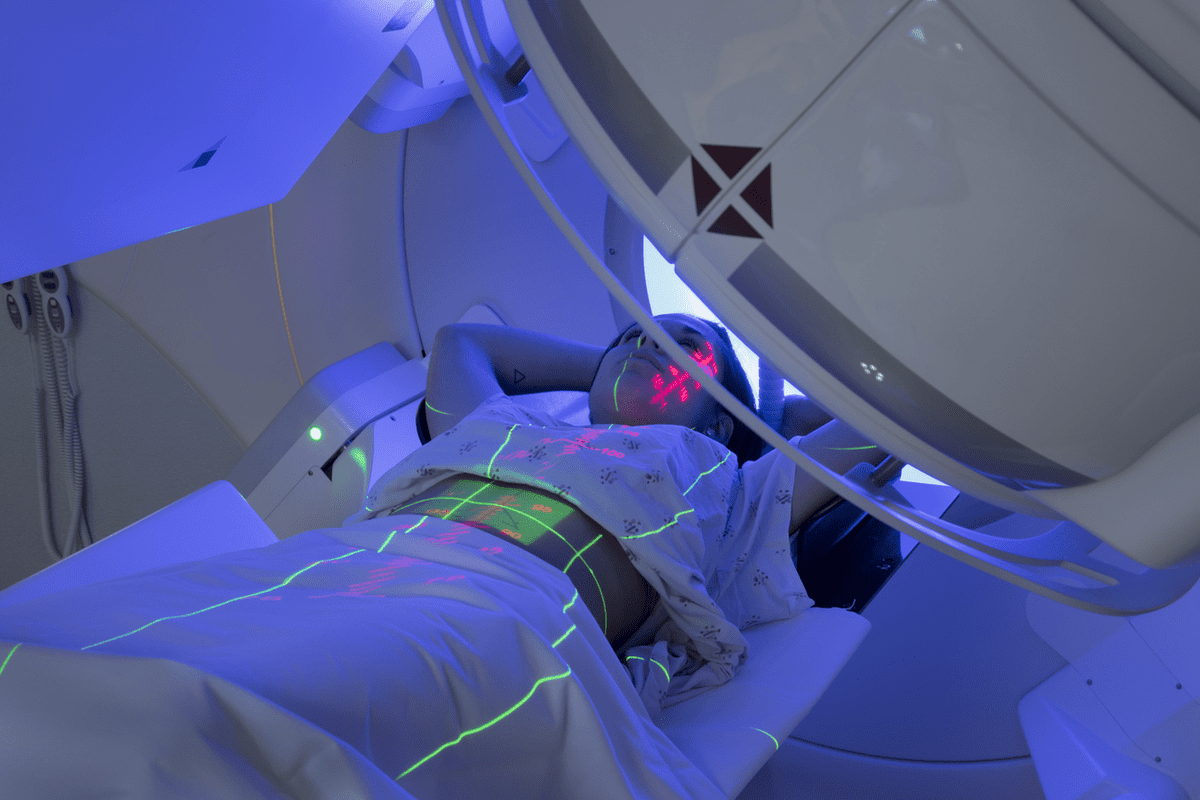Ovarian cancer is a significant health concern for women worldwide. Nearly 20,000 new cases are diagnosed in the United States every year. This leads many to ask: What Causes Ovarian Cancer?
Knowing the risk factors for ovarian cancer is key to catching it early. Stories like Therese Suchoski’s, a young survivor, show why we need to be aware and get help fast.
Looking into the causes and risk factors of ovarian cancer helps us understand it better.

Key Takeaways
- Ovarian cancer is a significant health concern for women worldwide.
- Understanding risk factors is key for early detection and prevention.
- Awareness and quick medical help are vital for ovarian cancer survivors.
- Many causes and risk factors are linked to ovarian cancer.
- Early detection and awareness can lead to better treatment outcomes.
Understanding Ovarian Cancer
Ovarian cancer is not just one disease. It’s a group of diseases that share some traits. This makes it important to understand for diagnosis and treatment. It starts in the ovaries, which are part of the female reproductive system.
Types of Ovarian Cancer
There are several types of ovarian cancer. They are classified based on where the cancer begins. The main types include:
- Epithelial ovarian cancer: This is the most common type, arising from the outer layer of the ovary.
- Germ cell ovarian cancer: These cancers begin in the cells that produce eggs.
- Stromal ovarian cancer: This rare type develops in the connective tissue of the ovary.
Within these categories, there are further subtypes. These include serous, mucinous, and clear cell carcinomas. Each has its own characteristics.
How Ovarian Cancer Develops
Ovarian cancer starts with genetic mutations in the ovary’s cells. This leads to uncontrolled cell growth. The exact cause of these mutations is often unclear. But, some risk factors can increase the chance of getting ovarian cancer.
The progression of ovarian cancer can be slow. Symptoms often show up in advanced stages. Knowing how ovarian cancer develops is key for early detection and effective treatment.
Causes of Ovarian Cancer
Ovarian cancer comes from genetic changes and hormonal effects. Knowing these causes helps us find risk factors and prevent the disease.
Cellular Mutations and DNA Damage
Genetic changes and DNA damage are key in ovarian cancer. Genetic mutations can happen from inherited traits or environmental factors.
DNA damage can come from mistakes in DNA copying or from outside factors like radiation and chemicals. If these damages aren’t fixed, they can cause cancer.
Hormonal Influences
Hormones also play a big role in ovarian cancer. Hormones like estrogen can make ovarian cells grow, which might lead to cancer.
Studies show that how hormones are affected by things like reproductive history and hormone therapy can change cancer risk.
| Risk Factor | Description | Impact on Ovarian Cancer Risk |
| Genetic Mutations | Inherited or acquired mutations in genes such as BRCA1 and BRCA2 | Increased risk |
| Hormone Replacement Therapy | Use of hormones to alleviate menopausal symptoms | Potential increase in risk |
| Reproductive History | Factors including age at first pregnancy and number of pregnancies | Variable impact |
Is Ovarian Cancer Genetic?
Genetic factors are key in ovarian cancer. Certain mutations greatly increase the risk. The link between genetics and ovarian cancer is complex, involving many genes and inherited conditions.
BRCA1 and BRCA2 Mutations
Mutations in the BRCA1 and BRCA2 genes are major risk factors for ovarian cancer. These genes help fix damaged DNA. Without them, cancer risk goes up. Women with these mutations face a higher risk of ovarian cancer, often at a younger age.
The frequency of BRCA1 and BRCA2 mutations varies by population. Yet, they cause a big part of hereditary ovarian cancers. Testing for these mutations can spot high-risk individuals early, leading to preventive steps.
Lynch Syndrome and Other Genetic Conditions
Lynch syndrome, or hereditary nonpolyposis colorectal cancer (HNPCC), also raises ovarian cancer risk. It’s caused by mutations in DNA mismatch repair genes. People with Lynch syndrome face a higher risk of cancers, including ovarian.
Other genetic conditions, like Peutz-Jeghers syndrome, can also up the risk of ovarian cancer. Knowing these genetic factors is key for assessing risk and planning screenings and prevention.
Can Ovarian Cancer Run in Families?
Yes, ovarian cancer can run in families, often due to inherited genetic mutations. Families with a history of ovarian, breast, or other cancers may carry specific mutations like BRCA1 and BRCA2. These mutations can significantly raise the risk of ovarian cancer across generations.
For those with a family history of ovarian cancer, genetic counseling and testing are very helpful. They offer insights into risk. This knowledge helps individuals make informed health decisions, including preventive measures like surgery or enhanced surveillance.

Age and Reproductive History as Risk Factors
Age and reproductive history are important in determining ovarian cancer risk. Knowing how these factors interact can help understand a woman’s risk level.
Age-Related Risk
The risk of ovarian cancer goes up with age, mainly after 50. Most cases are found in women during or after menopause. This shows age is a big risk factor.
Age Distribution of Ovarian Cancer Risk
| Age Group | Relative Risk |
| Before 40 | Low |
| 40-49 | Moderate |
| 50-59 | Higher |
| 60 and above | Highest |
Pregnancy, Childbirth, and Ovarian Cancer Risk
Reproductive history, including pregnancy and childbirth, affects ovarian cancer risk. Women who have been pregnant and given birth have a lower risk than those who haven’t.
The protective effect of pregnancy is due to changes in ovarian function and hormonal influences during pregnancy. The more pregnancies a woman has, the lower her risk of ovarian cancer.
Understanding these risk factors can help assess individual risk. It can also guide preventive measures.
Hormonal and Gynecological Risk Factors
Hormonal and gynecological factors are key in figuring out ovarian cancer risk. They tie into a woman’s reproductive history and hormonal changes over her life.
Menstruation and Menopause
The length and type of a woman’s menstrual cycle and when she goes through menopause matter. Women who start menstruating early or enter menopause late might face a higher risk. This is because they are exposed to estrogen for longer.
Studies show that how many times a woman ovulates in her life can affect her risk. Things like pregnancy and breastfeeding, which lower ovulation, can also lower ovarian cancer risk.
Hormone Replacement Therapy
Hormone replacement therapy (HRT) helps with menopause symptoms. But, using HRT, mainly estrogen-only therapy, can raise ovarian cancer risk. The risk depends on how long it’s used and the hormones involved.
Endometriosis and Ovarian Cancer
Endometriosis, where uterine lining tissue grows outside, ups ovarian cancer risk. Women with endometriosis should talk to their doctors about their risk.
Knowing about these risk factors helps women and doctors make better health choices. This could lower ovarian cancer risk.
Can PCOS Cause Ovarian Cancer?
Research is ongoing to understand the link between PCOS and ovarian cancer. PCOS is a common disorder in women of childbearing age. It has been studied for its possible link to ovarian cancer.
Understanding the Relationship Between PCOS and Ovarian Cancer
The exact way PCOS might affect ovarian cancer risk is not clear. But, factors like hormonal imbalance, insulin resistance, and inflammation are thought to play a role.
Hormonal influences are key in both PCOS and ovarian cancer. Women with PCOS often have high androgen levels and irregular ovulation. This could affect their risk of ovarian cancer.
Current Research Findings
Research on PCOS and ovarian cancer risk has shown mixed results. A meta-analysis in a top medical journal found a slight increase in risk. But the overall risk is low.
Looking closely at the research, we find some key points:
| Study | Population | Findings |
| Study A | 1,000 women with PCOS | Slightly increased risk of ovarian cancer |
| Study B | 5,000 women with PCOS | No significant association found |
| Study C | 2,000 women with PCOS and family history of ovarian cancer | Moderate increase in ovarian cancer risk |
These studies highlight the need for more research. We need to understand how PCOS affects ovarian cancer risk in different groups.
Birth Control and Ovarian Cancer Risk
Oral contraceptives, a common form of birth control, have been linked to a lower risk of ovarian cancer. This is good news for women’s health. It’s because many women use oral contraceptives and ovarian cancer is common.
Protective Effects of Oral Contraceptives
The use of oral contraceptives has been shown to decrease the risk of developing ovarian cancer. Studies have found that the longer a woman uses them, the lower her risk becomes. This effect can last even after stopping the use of oral contraceptives.
A key factor in this protective effect is the reduction in the number of ovulations a woman experiences. Ovulation is believed to contribute to the risk of ovarian cancer. This is because ovulation causes damage and repair to the ovarian surface.
Do Birth Control Pills Cause Ovarian Cysts?
There’s a common worry that birth control pills may cause ovarian cysts. But research shows that oral contraceptives can actually lower the risk of ovarian cysts. They do this by stopping new cysts from forming and shrinking existing ones.
It’s important for women to talk to their healthcare provider about their individual risks and benefits. While oral contraceptives protect against ovarian cancer, they also have risks and side effects.
In conclusion, the link between birth control and ovarian cancer risk is complex. Oral contraceptives have been shown to protect against ovarian cancer. This is a significant benefit for women’s health.
Lifestyle and Environmental Risk Factors
Ovarian cancer risk comes from many lifestyle and environmental factors. Knowing these can help people lower their risk of getting ovarian cancer.
Obesity and Diet
Research shows that obesity raises the risk of many cancers, including ovarian cancer. Eating too much processed food and not enough nutrients also increases this risk. It’s important to eat well and stay active to keep a healthy weight.
A study in the Journal of Clinical Oncology found that women with a higher BMI had a higher risk of ovarian cancer. This compared to those with a lower BMI.
“The relationship between obesity and ovarian cancer risk is complex and involves multiple factors, including hormonal influences and chronic inflammation.”
Smoking and Alcohol Consumption
Smoking is a known risk factor for many cancers, including ovarian cancer. While the evidence is not as strong, smoking is thought to increase ovarian cancer risk, mainly for certain types.
Alcohol consumption is also being studied as a risk factor. Some studies suggest that drinking a lot of alcohol may slightly raise ovarian cancer risk.
| Lifestyle Factor | Impact on Ovarian Cancer Risk |
| Obesity | Increased risk, mainly for certain types |
| Smoking | Potential increased risk, mainly for mucinous ovarian cancer |
| Alcohol Consumption | Moderate to heavy drinking may slightly increase risk |
Environmental Exposures
Being exposed to certain environmental toxins and pollutants might raise ovarian cancer risk. The evidence is growing, but it’s key to know about these dangers.
By understanding and tackling these lifestyle and environmental risks, people can make choices to lower their ovarian cancer risk.
Can You Get Ovarian Cancer After Menopause?
Menopause is a big change in a woman’s life. It’s important to know how it affects ovarian cancer risk. While ovarian cancer risk goes up with age, most cases are found in women after menopause. The symptoms can be hard to spot, making it tough to diagnose.
There are many things that can raise the risk of ovarian cancer in women after menopause. Knowing these risk factors is key to finding cancer early and treating it.
Post-Menopausal Risk Factors
Women after menopause face several risks for ovarian cancer. These include:
- Age: The risk of ovarian cancer goes up with age, with most cases in women over 50.
- Family History: Having a family history of breast, ovarian, or other cancers can raise the risk.
- Genetic Mutations: Mutations in genes like BRCA1 and BRCA2 can greatly increase the risk of ovarian cancer.
Knowing these risk factors can help find cancer early. This can help lower the risk through the right management.
Symptoms and Detection in Older Women
Finding ovarian cancer in older women can be hard. This is because the symptoms are often not clear and can be caused by other things. Common symptoms include:
- Abdominal bloating or swelling
- Pelvic pain or discomfort
- Difficulty eating or feeling full quickly
- Urinary urgency or frequency
If symptoms don’t go away, it’s important to see a doctor. Finding cancer early is key to treating it well.
The table below shows important risk factors and symptoms for ovarian cancer in women after menopause:
| Risk Factors | Symptoms |
| Age over 50 | Abdominal bloating |
| Family history of cancer | Pelvic pain |
| Genetic mutations (BRCA1, BRCA2) | Urinary urgency |
| Hormone replacement therapy | Difficulty eating or feeling full |
Understanding these factors and watching for symptoms can help find ovarian cancer early in women after menopause.
Ovarian Cancer in Men: Is It Possible?
Ovarian cancer in men seems odd because men don’t have ovaries. Yet, knowing about male reproductive parts and cancers can shed light on this topic.
Understanding Male Reproductive Anatomy
Men’s bodies have different parts than women’s, like the testes, epididymis, and prostate. The testes make sperm and testosterone, key for fertility and sex health. Men don’t have ovaries, but other cancers can affect their reproductive system.
Related Cancers in Men
Men can’t get ovarian cancer like women do. But, they can get testicular cancer, which starts in the testes. This cancer is rare but common in young and middle-aged men. Prostate cancer is another concern, affecting the prostate gland.
Testicular Cancer has a high cure rate if caught early. Look out for lumps, pain, or a heavy feeling in the scrotum. Regular self-examination helps catch it early.
Prostate Cancer is more common in older men. It’s linked to age, family history, and genetic changes. Tests like PSA and digital rectal exams help screen for it.
In summary, men can’t get ovarian cancer because they don’t have ovaries. But, they face risks from other reproductive cancers. Knowing the risks and symptoms can help catch these cancers early for better treatment.
How to Prevent Ovarian Cancer
Preventing ovarian cancer requires a mix of lifestyle changes and regular health checks. While we can’t remove all risk, some steps can lower it.
Lifestyle Modifications
Healthy choices in your lifestyle can help fight ovarian cancer. Here are some ways to do it:
- Dietary Changes: Eating lots of fruits, veggies, and whole grains boosts health and might cut cancer risk.
- Exercise Regularly: Staying active improves health and may protect against ovarian cancer.
- Maintain a Healthy Weight: Being overweight raises cancer risk, including ovarian cancer. Eating right and exercising helps keep a healthy weight.
Medical Interventions
Some medical steps can also lower ovarian cancer risk. These include:
- Oral Contraceptives: Taking birth control pills can lower ovarian cancer risk. The more you use them, the more protection you get.
- Risk-Reducing Surgery: Women at high risk, like those with BRCA1 or BRCA2, can benefit from removing their ovaries and fallopian tubes.
Regular Screening and Monitoring
Women at high risk need regular checks. This might include:
- Transvaginal Ultrasound: Ultrasounds help find cancer early.
- CA-125 Blood Test: Watching CA-125 levels can spot cancer early, but it’s not a sure sign.
| Prevention Strategy | Description | Benefit |
| Lifestyle Modifications | Dietary changes, regular exercise, maintaining a healthy weight | Reduces overall cancer risk, improves health |
| Oral Contraceptives | Use of birth control pills | Reduces ovarian cancer risk |
| Risk-Reducing Surgery | Surgical removal of ovaries and fallopian tubes | Significantly reduces risk for high-risk individuals |
| Regular Screening | Transvaginal ultrasound, CA-125 blood test | Aids in early detection |
Ovarian Cancer Genetics and Testing
Identifying genetic mutations is key to understanding and potentially preventing ovarian cancer. Genetic testing can reveal mutations that significantly increase the risk of developing ovarian cancer. This allows for early intervention and informed decision-making.
Who Should Consider Genetic Testing
Genetic testing is recommended for individuals with a family history of ovarian or breast cancer. BRCA1 and BRCA2 mutations are well-known risk factors. Testing can identify these mutations.
Other factors that may necessitate genetic testing include:
- A personal history of ovarian or breast cancer
- A family history of these cancers, in first-degree relatives
- Known genetic mutations within the family
“Genetic testing is a powerful tool in the fight against ovarian cancer.”
Understanding Your Test Results
Receiving genetic test results can be daunting. A positive result indicates a mutation that may increase cancer risk. A negative result is reassuring but not a guarantee against developing cancer.
It’s essential to consult with a genetic counselor or healthcare provider. They can help you understand your test results fully. They can guide you on:
- The specific mutations identified
- Risk management strategies
- Options for preventive measures or surveillance
Understanding your genetic risk can empower you to take proactive steps towards your health. Whether through increased surveillance or preventive measures, knowing your genetic status is a key step in managing your risk of ovarian cancer.
American Cancer Society Research on Ovarian Cancer
The American Cancer Society leads in ovarian cancer research, looking into new ideas and projects. Their work is key to figuring out what causes ovarian cancer and finding good treatments.
Emerging Theories on Causes
New studies have uncovered possible reasons for ovarian cancer. The American Cancer Society is looking into things like genetic changes and how the environment affects us.”The role of genetics in ovarian cancer cannot be overstated. Research into genetic predispositions is ongoing, with significant implications for prevention and treatment.”
Current Research Initiatives
The American Cancer Society is backing several research projects on ovarian cancer. These projects include studies on early detection methods and new ways to treat the disease. By supporting new research, the Society hopes to help more patients with ovarian cancer.
Some of the ongoing research projects are:
- Looking into how BRCA1 and BRCA2 mutations affect ovarian cancer
- Checking if immunotherapy can help treat ovarian cancer
- Creating custom treatments based on a person’s genes
As research keeps growing, the American Cancer Society stays dedicated to learning more about ovarian cancer. They aim to improve care for patients.
Conclusion: Understanding Your Personal Risk
Knowing your risk for ovarian cancer is key to catching it early and preventing it. We’ve looked at many risk factors, like genetic changes, hormones, and lifestyle choices.
Being aware of these can help you lower your risk. For example, knowing your family’s health history and genetic risks can guide your health choices. Also, eating well and exercising regularly can help.
Talking to your doctor about your risk factors is vital. They can suggest the best steps for you. By understanding and managing your risk, you can protect your health and lower your chance of ovarian cancer.
* Liv Hospital Editorial Board has contributed to the publication of this content .
* Contents of this page is for informational purposes only. Please consult your doctor for diagnosis and treatment. The content of this page does not include information on medicinal health care at Liv Hospital .
For more information about our academic and training initiatives, visit Liv Hospital Academy
FAQ
What are the main causes of ovarian cancer?
Ovarian cancer comes from a mix of genetic and environmental factors. This includes cell mutations, DNA damage, and hormonal effects.
Is ovarian cancer genetic?
Yes, ovarian cancer can have a genetic link. Mutations in genes like BRCA1 and BRCA2, and Lynch syndrome, raise the risk.
Can ovarian cancer run in families?
Yes, ovarian cancer can be hereditary. People with a family history of ovarian or breast cancer are at higher risk.
How does age affect the risk of ovarian cancer?
The risk of ovarian cancer goes up with age. Most cases happen in women over 50.
Can pregnancy and childbirth affect ovarian cancer risk?
Yes, pregnancy and childbirth can lower ovarian cancer risk. Women with multiple pregnancies are at lower risk.
Is there a link between PCOS and ovarian cancer?
Research is ongoing, but it seems women with PCOS might face a higher risk of ovarian cancer. More studies are needed to confirm this.
Do birth control pills cause ovarian cysts?
Birth control pills can sometimes cause ovarian cysts. But they also protect against ovarian cancer.
Can lifestyle and environmental factors contribute to ovarian cancer risk?
Yes, lifestyle and environmental factors can increase ovarian cancer risk. This includes obesity, diet, smoking, and exposure to toxins.
Can you get ovarian cancer after menopause?
Yes, ovarian cancer can occur after menopause. Post-menopausal women should know the symptoms and risk factors.
Can men get ovarian cancer?
No, men cannot get ovarian cancer because they do not have ovaries. But they can get testicular cancer, a different type of cancer.
How can ovarian cancer be prevented?
Preventing ovarian cancer involves lifestyle changes, medical interventions, and regular screening. This is important for those at high risk.
Who should consider genetic testing for ovarian cancer?
People with a family history of ovarian or breast cancer, or those with known genetic mutations, should consider genetic testing.
What is the American Cancer Society doing to research ovarian cancer?
The American Cancer Society is researching ovarian cancer causes. They explore new theories and current research initiatives.







